Boca Juniors won the title by being the last challenger standing
Categories: Team Performance
There are a number of narratives that one can use to describe the recently concluded Primera División season in Argentina, and I hope to explore some of them in future posts that review the championship. In this post I’m going to look at the performance metrics to assess the conjecture that Boca Juniors won the title because there was no other challenger ready to lay claim to it.
I was close to embracing this conjecture on my own, but my own thinking was validated by this piece by LA NACION’s Cristián Grosso that was published the day after Banfield’s defeat to San Lorenzo handed the title to Boca. It’s in Spanish, of course, but the main argument was that this Primera División season was a forgettable one with an ultimately forgettable champion, a champion with rivals that “lacked the stature in some cases and conviction in others to take on a leader who, despite winning the title, was always an unstable and disconcerting side” (my translation).
So what do the data say about this argument? Boca deserved to be champion, that much is clear. But were they fortunate to have the challengers that they had this season?
To examine this question I look at the performance metric that matters most to every club: league points. I consider the full league program of Boca Juniors and six prospective challengers — Estudiantes, Banfield, Newell’s Old Boys, Racing Club and River Plate. For each of these teams, I calculate the points won for every league match and then compute a five-match rolling average of points per match. I want to see how the points gap to Boca Juniors changes over the championship, so I compute the points difference as a function of the tournament matchday. (It’s not perfect because some matches were rescheduled to a later date, but it’s close enough for my purposes.)
Let’s start this analysis with the only teams other than Boca to lead the championship: River Plate and Estudiantes de La Plata. River led the league very briefly (after Rounds 1 and 2) but were never more than three points in front of Boca. After Round 8, Boca moved ahead of River and stayed ahead for the rest of the tournament. River’s league form fell off in a big way during the first half of the tournament, yet they recovered and out-paced Boca in the second half to the point that if they had won their last five matches they would have been champions. One point from matches in Rounds 26, 27, and 28 ended their challenge.
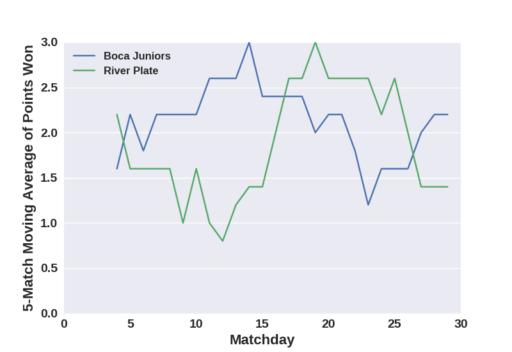
Comparison of 5-match rolling PPG average between Boca Juniors and River Plate, Primera División Argentina, 2017-18 season. Data supplied by DataFactory LatAm.
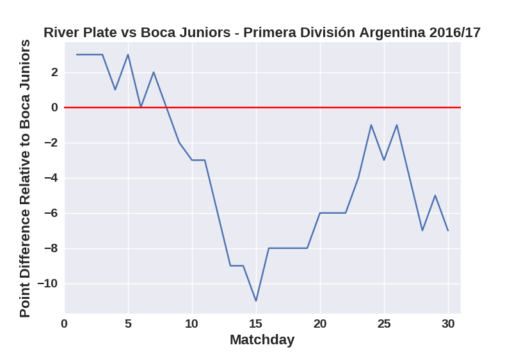
League point difference between River Plate and Boca Juniors as function of matchday, Primera División Argentina, 2017-18 season. Data supplied by DataFactory LatAm.
Estudiantes were the other team that led the championship, from Rounds 3 to 12. El Pincha had a stronger start to the season than Boca, but their form cratered over the remainder of the spring half of the season. To make their situation even worse, Boca were at their peak level of performance over the whole of the championship. Estudiantes’ form recovered and ran similar to Boca’s in the latter third of the season, but they never recovered from the damage.
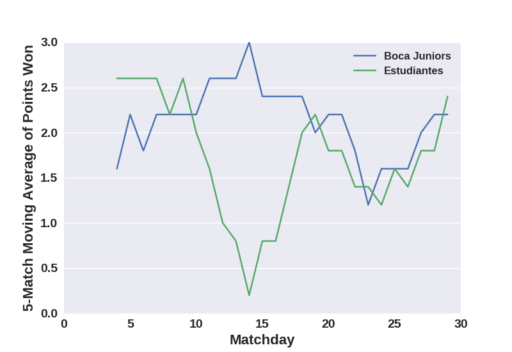
Comparison of 5-match rolling PPG average between Estudiantes (LP) and Boca Juniors, Primera División Argentina, 2016-17 season. Data supplied by DataFactory LatAm.
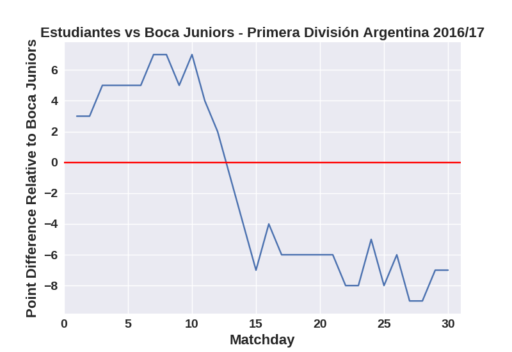
League point difference between Estudiantes LP and Boca Juniors as function of matchday, Primera División Argentina, 2017-18 season. Data supplied by DataFactory LatAm.
For much of the tournament, Racing looked like a side who — according to their xG — should have been higher in the table than they were. Like Estudiantes, they hit a particularly deep trough in their performance during the middle part of the season and by the time they were winning points at a similar rate to Boca, it was too late for their title aspirations.
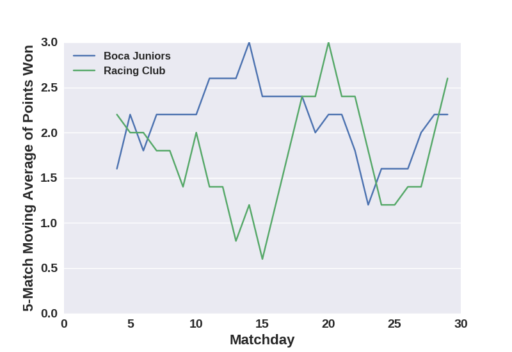
Comparison of 5-match rolling PPG average between Racing Club and Boca Juniors, Primera División Argentina, 2016-17 season. Data supplied by DataFactory LatAm.
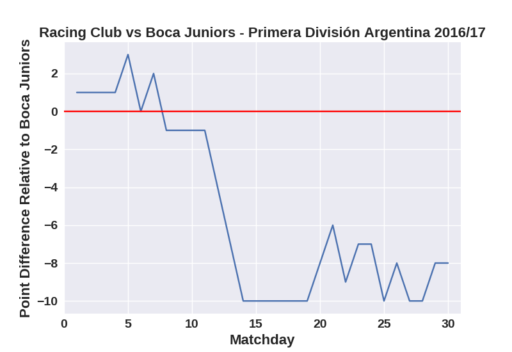
League point difference between Racing Club and Boca Juniors as function of matchday, Primera División Argentina, 2017-18 season. Data supplied by DataFactory LatAm.
The big surprise according to the expected goal metric in this season’s Primera was Newell’s Old Boys. Their offensive xG performance was worse than all of this season’s relegated teams, yet they had the second-highest shot conversion rate in the competition. Next to Estudiantes, they had one of the most sustained leads to Boca in the championship, at least until Round 12. After that, Newell’s were never a threat for the title aside from a brief boomlet at around Round 20. Newell’s chose the closing weeks of the championship to enter a tailspin.
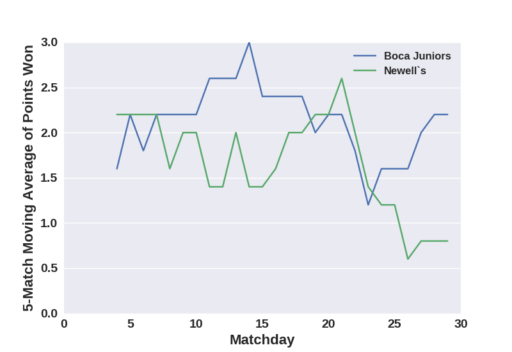
Comparison of 5-match rolling PPG average between Newell’s Old Boys and Boca Juniors, Primera División Argentina, 2016-17 season. Data supplied by DataFactory LatAm.
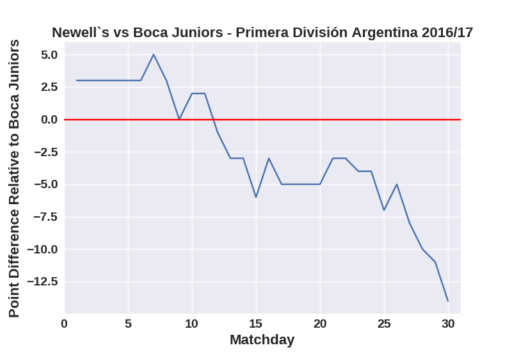
League point difference between Newell’s Old Boys and Boca Juniors as function of matchday, Primera División Argentina, 2017-18 season. Data supplied by DataFactory LatAm.
That brings us to Banfield, who were the last team that could have overtaken (theoretically) Boca in the table but ultimately finished fifth. Unlike River, Estudiantes, Racing, or Newell’s, Banfield never dipped below 1.0 PPG in the 5-match moving average. They outperformed Boca over much of the final third of the season which gave them an outside shot at winning the title. But if you look at the moving average between the sides, Boca had a persistent gap in PPG which helped to widen the point differential. Banfield never overtook Boca over the entire championship.
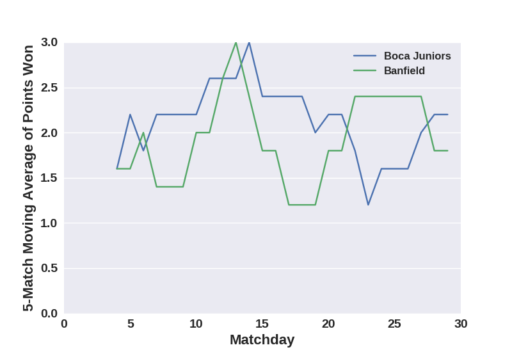
Comparison of 5-match rolling PPG average between Banfield and Boca Juniors, Primera División Argentina, 2016-17 season. Data supplied by DataFactory LatAm.
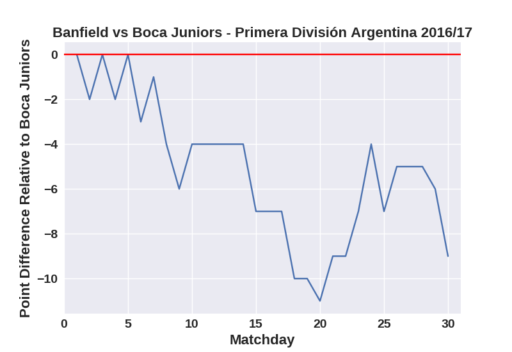
League point difference between Banfield and Boca Juniors as function of matchday, Primera División Argentina, 2017-18 season. Data supplied by DataFactory LatAm.
So that’s the story of the championship. Would-be rivals to the title hit deep troughs and brief peaks in performance, and as a result Boca Juniors attained a lead in the Primera División that it would not relinquish. Those who were able to get within striking distance of the Xeneizes were limited by their own inexperience (in the case of Banfield) or their lack of poise (in the case of River).
In the end, Boca Juniors won this season’s Primera División clearly and deservedly. They also won because their challengers crumbled into dust.
All match data is supplied by DataFactory Latinoamericano. All analysis is my own.

